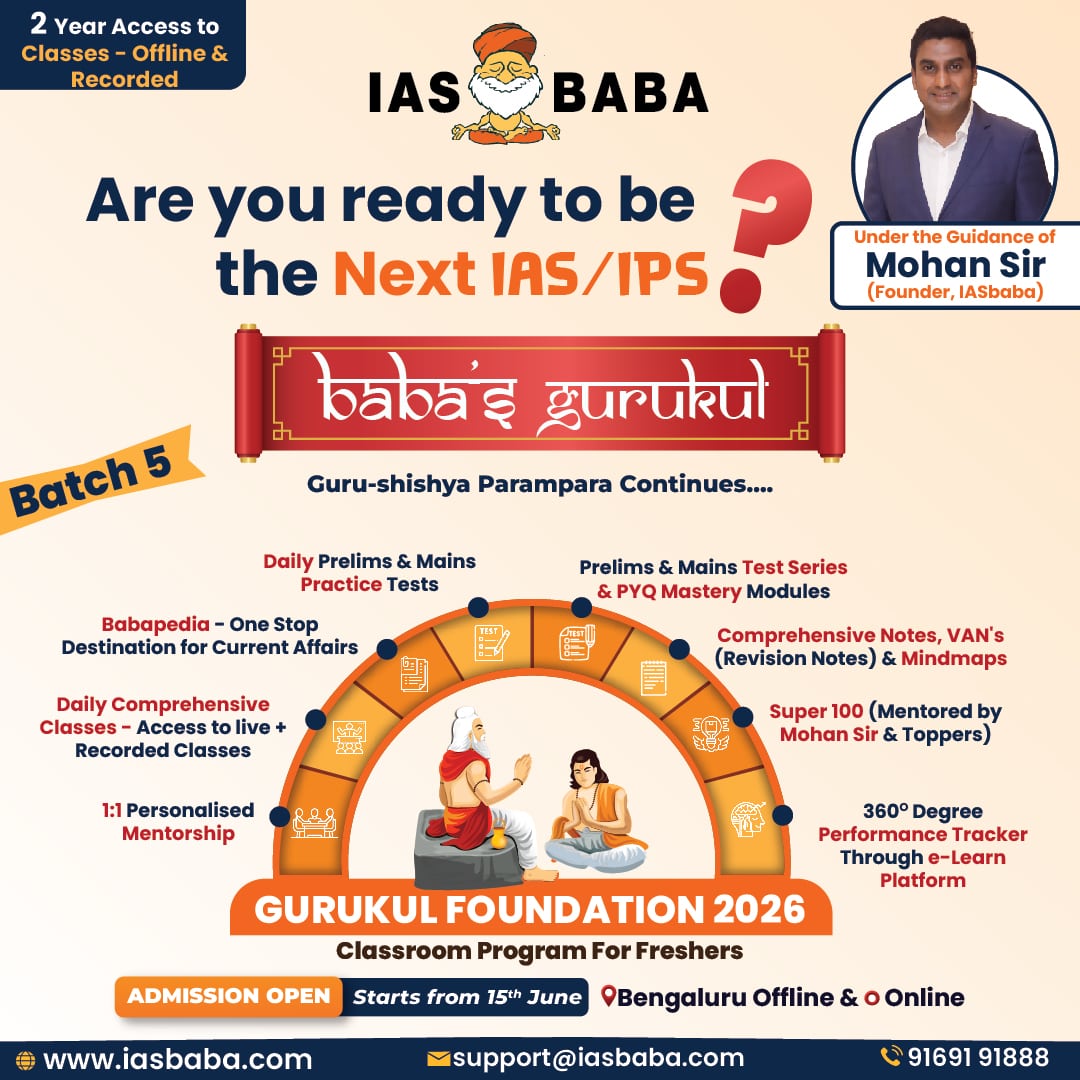IASbaba's Hot Questions, IASbaba's Think Learn Perform 2016, IASbaba's TLP - 2016, Think Learn Perform (TLP)- 2016, UPSC Mains Answer Writing - 2016, UPSC Mains Questions 2016
SYNOPSIS- IASbaba’s TLP 2016 [13th April] – UPSC Mains GS Questions [HOT]
1. Manifesto based Panchayati elections must become the norm in order to initiate agenda based governance. Do you agree? Analyse. Enumerate the benefits that would accrue from this change.
Intro:
Panchayats are envisaged as agents who can transform passive dormant citizenry into active collaborative assets.
Body:
- 73rd constitutional amendment act gave recognition to the panchayats, added a new part IX and new schedule 11 to the constitution. States are given the freedom to choose the structure for such institution, but even with this flexibility there is no improvement in the conditions of rural masses.
- Manifesto in the context of elections refers to the written document which is reiterated verbally and reflects the vision and mission of the party or the candidate, which it intends to bring into action when voted to power
- Currently the power equations are mainly governed by money, power-sharing pacts, caste & regional politics, and has largely hampered the realization of this vision of power-devolution.
- A plausible solution to this problem is presented by the process of manifesto based elections. It’s a process followed by political parties at national and state level elections where they forward their manifesto to the citizens that clearly outlines their agenda for development in future, ideals, stance on imp issues etc.
- It helps the political pundits, media to break down & predict future policies of the government helping the citizens in making an informed choice.
Benefits of making manifesto a norm:
- Clean-Up– of dirty politics, candidates will be compelled to come up with ideas that cater to all populace and not just their caste brethren.
- Enhanced responsibility– on panchayat leaders of standing by their word and work along the lines they promised to. Especially if the opposition is very strong.
- accountability- during next round of elections where leaders can be judged on what they promised and how much they actually did, thus discarding candidates not performing for the public good.eg., it will act as an yardstick to measure the actual progress as against what was promised.
- Better local policies– a bottom up approach with clearly articulated needs objectives will highlight the mismatch between the local needs and state government’s policies; this will help in streamlining the policies and better implementation.
Conclusion:
Write a suitable conclusion.
Best answer: IAV
A written record gives immortality to the words in it. They act as good control and feedback mechanisms for the future. I believe manifesto based panchayati election would prove the same.
In addition to control and feedback it leads to:
1) better, structured, thought-out agenda of the candidates showing commitment of the candidates before elections.
2) choice to people based on substance rather than mere words
3) it can act as a report card at the end of term and the basis for future elections and give visibility to political organizations on their candidates performance.
4) Leads to an outcome based approach to governance since manifestos provide the strategic intent of candidates rather than just numbers( output based approach).
5) During the tenure, it provides milestones to the elected representatives.
6) Bring systems and processes, accountability and transparency in local governance, thus making it more participatory in nature.
Yet, there are challenges for the same as below:
1) Some local bodies may not have literate population to read and follow up on the manifesto.
2) Some local bodies may not have candidates who can read, some may not have adequate capacity to plan for future.
3) Having control and feedback mechanism makes sense when there is a right to recall, which is non-existent currently.
We can overcome such constraints by adequate training, involvement of civil society organizations. It is the states mandate to tell its election commission to do the necessary. Given that powers are not being devolved to panchayati institutions such focus on them for transparency and process-based governance seems distant.
2. It is high time that the idea of joint command for the armed forces is mooted and implemented. Critically examine.
Introduction:
Chief of Defence Staff (CDS) post, under Govt of India, becomes necessary that 3 arms of defence forces should have a coherent, consistent and coordinated vision, policy and action, as envisaged by Naresh Chandra Committee, because:
-Emergence of ISIS and their expansion possess threat
-India is surrounded by hostile neighbours and has a very large area and long coastline to defend.
-Cross border attack by terrorist groups mostly Pakistan based. E.g.: Pathankhot and Mumbai attack
-Withdrawal of NATO arise threat of Taliban in Kashmir.
Need:
- Coordination: Modern warfare has become highly complex affairs and it calls for enhanced cooperation between the different wings of the armed forces where they can smoothly integrate to present a formidable force against enemy forces.
- Defence planning: A holistic planning clearly specifying the role of different wings of armed forces can take place by a joint command officer only.
- The lack of joint command affects the overall defence management related to rationalization of defence manpower, strategic decision making related to capacity building, conflict in the allocation of resources.
- Secretary of defence has no specialization in this regard. CDS will remover that problem.
Apprehension:
- Powerful CDS and Military coup on civil Administration as seen in Pakistan and Myanmar. Similar despotic CDS could be seen in India.
- Inter services apprehension about domination of one force over the other. Initially air force opposed this idea in view of domination of large army.
- Bypassing of three chiefs in taking key decisions.
- Doubt about level of expertise that a single person from one service having on other two services.
Conclusion:
In designing the role and responsibilities for CDS, India needs more research and excellent observatory vision towards similar kind of authority in other nations’ defence forces to establish best unified joint commanding authority.
Best answer: vengeance
Kargil Review Committee, followed by Arun Singh report in 2001 made recommendation of joint command for armed forces with creation of Chief of Defense Staff (CDS). Since then, little has been talked about this issue, let’s examine it critically.
Positives:
1) Will result in more Comprehensive document giving broader strategy of military capabilities, present Directives given by 3 wings of Armed Forces are very generic & separate in nature.
2) CDS will create greater coordination between armed forces due to single line of command & better inter & intra department understandings.
3) Acquisitions & purchases are often delayed due to multiple lines of commands; this problem can be sorted out.
4) Responsibility will be focused on 1 single person who will lessen chances of blame-game between various forces in case of tragedies, and attacks.
Negatives:
1) CDS will become too powerful & may threaten the very spirit of democracy by installing fear of coup among Executive.
2) Might undermine importance of 3 Service Chiefs who have considerate level of expertise in their respective fields.
3) India has fought wars mostly on land, with integration Land army might get upper hand which might distort basic fabric of equilibrium between forces as happened in China.
4)CDS will not have requisite experience in other 2 services due to which he may unknowingly take wrong decisions hampering India’s security.
Idea of joint command was recently applied in China in 2011, responses have been mixed & calls have erupted for following similar pattern in India. But one should remember, “Comparable must be compared”, & caveats should be followed on such a sensitive issue directly affecting India’s territorial integrity & sovereignty.
3. The increasing acceptance of intercaste marriages on one hand and heightened violence in the form of honor killing on the other portray contrasting pictures of India. Why do such differences arise in our society? Analyze.
Introduction
Inter-caste marriage was considered to be a severe taboo for Hindus and was considered to be sinful by almost all castes and there was complete societal ban on such marriages. Now there has been increased acceptance for intercaste marriage in our society, however, still many cases of Honour killing are prevalent. Following reasons can be attributed to this contrast:
Analysis: Your answer should include some of the following (Choose any 5-6 points)
- Rigid caste and varna system – Restriction of Marriage is one of the basic features of the caste. Not only inter-caste marriages were banned and prohibited but even inter-varna marriages too were discouraged by the Hindu scriptures and its ancient, medieval and modern philosophy. In order to discourage inter-varna or inter-caste marriages, various types of degradations were laid down for the progeny of such parents who had violated the societal norms and entered into wedlock with person of caste which was different than his or her own caste or varna.
- Religion – an important cause for disparities as certain culture follow the practice of wealth accumulation by marrying within families – Parsi, Jain, Andhra region etc – added burden on young ones of the family.
- Caste as source of power – When caste becomes source of power, like candidate of particular caste are preferred in particular region for election, then protecting the caste seems to be important for the people. This creates intolerance for any intercaste marriage and encourages Honour killing.
- Social Ostracisation – Social boycott of individuals or families by caste panchayats forces people to do Honour killing.
- Changing value of society – Tradition versus Modernity – Some of us may give priority to economic values, human right and equality. Yet some may still consider the traditions to be sacrosanct, because they might have been kept bereft of the transition process. Non inclusive Development – Education, integration of global ideas, improved standard of living, peace of mind, allows us to be tolerant and broad minded. People who didn’t taste the fruits of development may still continue to rigidly follow caste and protect caste systems.
- Western Influence on Youth – Youth is also drawing inspiration from Western cultures where libertarian and individualistic view is appreciated compared to community living of India.
- Political leadership – No political leader raise questions against caste division of our society. Rather caste grouping has become important political strategy. Such narrow political interest helps caste division to thrive. This encourages Honour killings.
- Extra govt institutions – Institutions such as Khap Panchayats in Haryana have actively supported honor killings and discouraged inter-caste marriages.
- Urbanization and declining female sex ratio – Due to urbanization people are migrating and also their narrow minded thinking is opening up and also decline in female sex ratio among communities is helping.
- Deeply embedded patriarchal notions and practices of control over a women- her mind, her body, her sexuality. Family honour being tied to social standing and mobility, it is justified to die and kill for that honour.
Conclusion
The issue of intercaste marriage is there to remain till such time we do not take steps to remove the caste based divide in the society. Govt and other organisations like NGOs etc can take step to spread awareness among the people and support intercaste marriage. In our ever changing society, we need to be open to inter caste marriages as it would have twin advantages of making our society a caste less society and also upholding the Right to Life and Liberity of couples who get married based on their consent rather than by societal norms.
Best answer El Nino
In ancient times occupation was the basis of caste. Later caste system became rigid on the basis of birth. Now there has been increased acceptance for intercaste marriage in our society. But still many cases of Honor killing is prevalent. Following reasons can be attributed to this contrast:
Level of intermixing: When human beings interact with others on day to day basis, tolerance, affection and acceptance of others culture and right increases. In city people are forced to interact in offices, organizations, services etc. In other areas where such teamwork doesn’t happen, rigid caste system and Honor killing persists.
Eg: In states like Bihar where level of industrialization is low problem exists, but in Delhi cases of Honor killing is less.
Caste as source of power – When caste becomes source of power, like candidate of particular caste are preferred in particular region for election, then protecting the caste seems to be important for the people. This creates intolerance for any intercaste marriage and encourages Honor killing.
Political leadership – No political leader raise questions against caste division of our society. Rather caste grouping has become important political strategy. Such narrow political interest helps caste division to thrive. This encourages Honor killings.
Social Ostracisation – Social boycott of individuals or families by caste panchayats forces people to do Honor killing.
Non inclusive Development – Education, integration of global ideas, improved standard of living, peace of mind, allows us to be tolerant and broad minded. People who didn’t taste the fruits of development may still continue to rigidly follow caste and protect caste systems.
Changing value of society – Some of us may give priority to economic values, human right and equality. Yet some may still consider the traditions to be sacrosanct, because they might have been kept bereft of the transition process.
Inclusivity, Political leadership, extensive campaign and persuasion for behavioral change can gradually bring our society out of the clutch of menace like Honor Killing.











